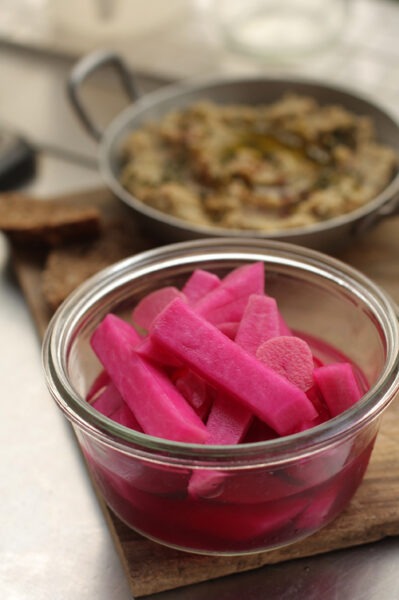If you’ve never pickled before, don’t be intimidated – this is the week to try it, as we’ve got some lovely turnips that you can turn into a very moreish side dish.
This one’s from David Lebovitz, and I second his enthusiasm for Middle Eastern breakfasts featuring this dish. He’s dyed his turnips pink with beet juice to make them extra pretty.
- 3 cups (750 ml) water
- 1/3 cup (70 g) coarse white salt, such as kosher salt or sea salt
- 1 bay leaf
- 1 cup (250 ml) white vinegar (distilled)
- 2-pounds (1 kg) turnips, peeled
- 1 small beet, or a few slices from a regular-size beet, peeled
- 3 cloves garlic, peeled and thinly sliced
1. In a saucepan, heat about one-third of the water. Add the salt and bay leaf, stirring until the salt is dissolved.
2. Remove from heat and let cool to room temperature. Once cool, add the vinegar and the rest of the water.
3. Cut the turnips and the beet into batons, about the size of French fries. Put the turnips, beets, and garlic slices into a large, clean jar, then pour the salted brine over them in the jar, including the bay leaf.
4. Cover and let sit at room temperature, in a relatively cool place, for one week. Once done, they can be refrigerated until ready to serve.
Storage: The pickles will keep for several weeks in the refrigerator. They’ll be rather strong at first, but will mellow after a few days. They should be enjoyed within a six weeks after they’re made, as they tend to get less-interesting if they sit too long.
Some tips from David on altering the recipe:
You can dial down the amount of garlic, but I like the slightly aggressive flavor of the slices in the brine. Use whatever white salt is available where you are, but avoid fine table salt as it’s quite unpleasant and bitter.
Gray salt will discolor the brine. For those who like to tinker, although these are usually served as they are, a few sprigs of fresh dill, or dill flowers, in the brine will take them in a different direction. A hot pepper will add some zip.
Recipe and photo from David Lebovitz
